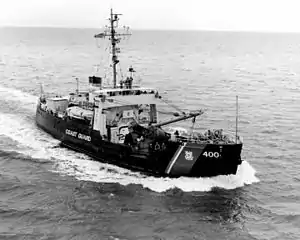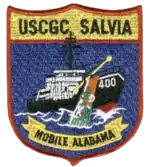USCGC Salvia (WLB-400)
The USCGC Salvia (WLB-400) was a Iris-class buoy tender belonging to the United States Coast Guard launched on 19 September 1943 and commissioned on 19 February 1944.[1]
 USCGC Salvia underway in 1971. | |
| History | |
|---|---|
| Name: | Salvia |
| Namesake: | Salvia plant |
| Builder: | Zenith Dredge Corporation |
| Laid down: | 24 June 1943 |
| Launched: | 19 September 1943 |
| Commissioned: | 19 February 1944 |
| Decommissioned: | 4 October 1991 |
| Fate: | 24 July 2020 reefed in Onslow Bay NC |
| Badge: |
 |
| General characteristics | |
| Class and type: | Iris-class buoy tender |
| Displacement: | 935 long tons (950 t) |
| Length: | 180 ft (55 m) |
| Beam: | 47 ft 1 in (14.35 m) |
| Draft: | 12 ft (3.7 m) |
| Propulsion: | 1 × electric motor connected to 2 Westinghouse generators driven by 2 Cooper Bessemer-type GND-8, 4-cycle diesels; single screw |
| Speed: |
|
| Complement: |
|
| Armament: |
|
Design
The Iris-class buoy tenders were constructed after the Mesquite-class buoy tenders. Salvia cost $923,995 to construct and had an overall length of 180 feet (55 m). She had a beam of 37 feet (11 m) and a draft of up to 12 feet (3.7 m) at the time of construction, although this was increased to 14 feet 7 inches (4.45 m) in 1966. She initially had a displacement of 935 long tons (950 t; 1,047 short tons); this was increased to 1,026 long tons (1,042 t; 1,149 short tons) in 1966. She was powered by one electric motor. This was connected up to two Westinghouse generators which were driven by two CooperBessemer GND-8 four-cycle diesel engines. She had a single screw.[1]
The Iris-class buoy tenders had maximum sustained speeds of 13 knots (24 km/h; 15 mph), although this diminished to around 11.9 knots (22.0 km/h; 13.7 mph) in 1966. For economic and effective operation, they had to initially operate at 8.3 knots (15.4 km/h; 9.6 mph), although this increased to 8.5 knots (15.7 km/h; 9.8 mph) in 1966. The ships had a complement of six officers and seventy-four crew members in 1945; this decreased to two warrants, four officers, and forty-seven men in 1966. They were fitted with a SL1 radar system and QBE-3A sonar system in 1945. Their armament consisted of one 3"/50 caliber gun, two 20 mm/80 guns, two Mousetraps, two depth charge tracks, and four Y-guns in 1945; these were removed in 1966.[1]
Career
| International radio call sign of USCGC Salvia (WLB-400)[1] | |||
| November | Oscar | Delta | Sierra |
After receiving her commission, Salvia was assigned to ATON and icebreaking duties in the Great Lakes. In May 1944, she was assigned to the 5th Coast Guard District and stationed in Portsmouth where she remained until the end of World War II.
After the war, she was homeported in Mobile, and continued to perform general ATON. In April 195,1 she was disabled in Calasieu Pass, and was towed back to port by Tampa. In December 1968, Salvia searched for survivors from the lost USCGC White Alder (WLM-541).
As of mid May, 2019 she is up for auction by the GSA (General Service Administration), lying in Virginia Beach, VA. She is in scrap condition, engines and most equipment removed. https://gsaauctions.gov/gsaauctions/aucindx/?sl=21QSCI19052004 .
In 2020 she was renamed the “Brian Davis” in memory of a local diver, and was sunk on 24 July in Onslow Bay, North Carolina as a part of an artificial reef project "AR-368".[2]
References
- "USCG Salvia". USCG. US Coast Guard. Retrieved 31 July 2015.
- "Artificial reef program sinks vessel off Topsail". The Coastland Times. Manteo NC. 27 July 2020. Archived from the original on 28 July 2020. Retrieved 28 July 2020.